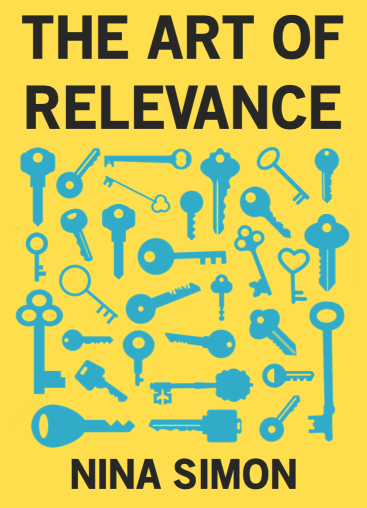
Book review: The Art of Relevance
Mark Robinson finds Nina Simon’s book essential reading for anyone trying to reach those disengaged from the arts.
Nina Simon, who is the Director of the Santa Cruz Museum of Art and History, and a leading museums thinker, was the punchiest keynote speaker at the recent AMA conference. I came away with a copy of The Art of Relevance, her new book, the themes of which she set out in her talk.
Relevance has the potential to give the other ‘R word’ a run for its money in the 2016 buzzword stakes, but we should not hold that against Nina or her argument. Using the images of rooms and keys and insiders and outsiders, the book is a sharp argument for mattering more to more people, not by assertion of your own intrinsic value but by making genuine connections. It uses stories and micro-case studies to illustrate how switching the terms in an open and ongoing fashion leads to change, and to relevance.
Anyone working in an arts or cultural organisation who is not entirely satisfied will find something in The Art of Relevance
Along the way there are a good number of highly quotable lines and arguments. Nina Simon begins by skewering two common delusions seen weekly in the arts: firstly, that what we do is relevant to everyone and secondly, that we don’t have to work on that relevance as people will find our work due to its distinctiveness. The key is that relevance is not about you: “It’s not about what you think people need to want or deserve. It’s about them – their values, their priorities.”
She goes on to deal with the old chestnut, “we shouldn’t be giving people what they want, our job is to give them what they need,” in a way that made something clearer to me than it had been before: “In my experience, the institutionally-articulated ‘needs’ of audiences often look suspiciously like the ‘wants’ of the professionals speaking… Let’s not sell short the power of giving people what they want. Cultural experiences should be a pleasure. They can also be educational, challenging, empowering, political… but they must first be something people want.”
One of the key points of the book is that if you want to be more relevant to some people, you must be prepared to change what you do and for your centre of gravity to shift so you become less relevant to others. Helping outsiders feel confident about entering your ‘room’ may unsettle the current insiders – it should certainly change the atmosphere. Many organisations talk the talk whilst attempting to reassure themselves and the insiders that they won’t lose any of their privileges.
I can certainly think of organisations that fit this description: “Many institutions take a schizophrenic middle ground on relevance. They swing between issuing press releases about change while reassuring insiders that none of the good stuff will be impacted. They pat themselves on the back in the morning and go to bed fearful at night.” (If someone at Arts Council England (ACE) isn’t fretting over how to make real change in the national portfolio without, err, making too much change in the national portfolio I’ll be surprised.)
Anyone working in an arts or cultural organisation who is not entirely satisfied will find something in The Art of Relevance. It should be compulsory reading for anyone in a ‘national’ organisation currently wondering how to get out to the regions to engage with communities perceived as having voted to leave the EU, for whom it has many useful lessons. (I say ‘perceived’ as people voted, not places, generally by fairly small margins. It wasn’t a series of local referenda.)
Firstly, as Nina Simon says, “now is the least useful form of relevance,” so any ‘listening’ to be done should not focus exclusively on one Yes/No question but the underlying issues it reflects. Secondly, Rufus Norris, or whoever, should be ready to be met on the doorstep (OK, my doorstep) by a variant of ‘where the bloody hell have you been till now?’ and to work to get over that hurdle.
Thirdly, national bodies – or anyone in ACE urging national bodies to work in places like Stockton, as appears to be happening – should make sure they start, not with what they do and want, but with the concerns of those they wish to engage. They need to be prepared to work in a radically different way, not restrict the ‘offer’ to current ways of working.
The starting point needs to be: ‘What matters or is useful to people in places like Hartlepool, Boston, and other places with big leave majorities?’ Not: ‘What can we do to help people in these places be part of a more cohesive or creative society?’ If Nina Simon is right, and I think she is, only when people ask the first question first can they hope to make progress on the second.
This does not, of course, mean putting your own values to one side. If anything it means being clearer about them, so that you can develop lasting relevance rooted in all the awkwardness of honest relationships rather than provisional, contingent ones.
Mark Robinson is the founder of Thinking Practice.
www.thinkingpractice.co.uk
First published on Mark Robinson’s blog.
Join the Discussion
You must be logged in to post a comment.